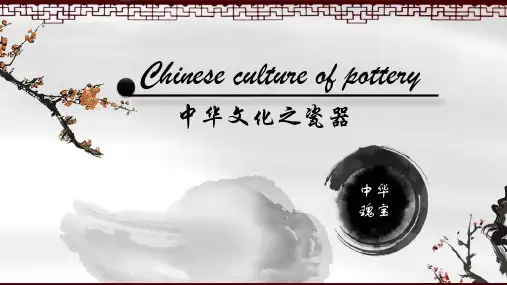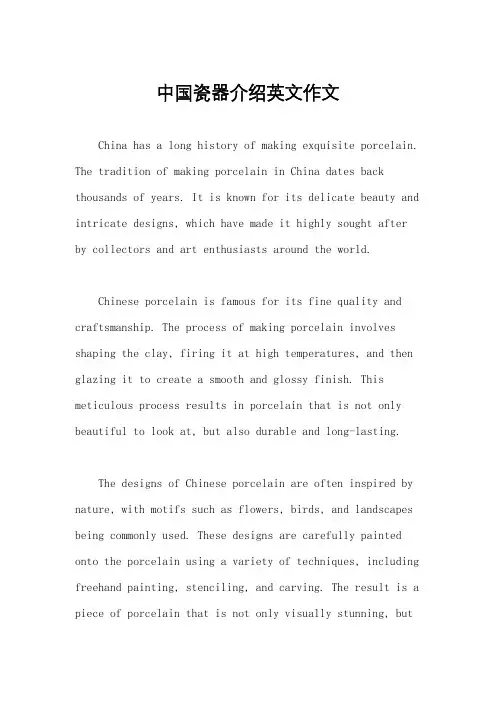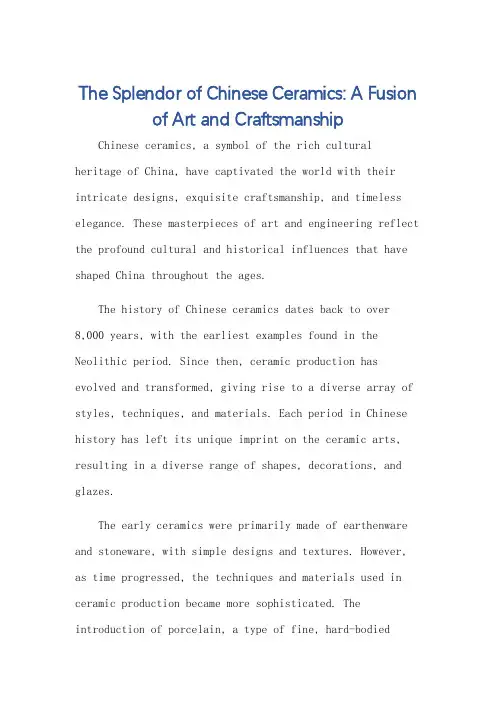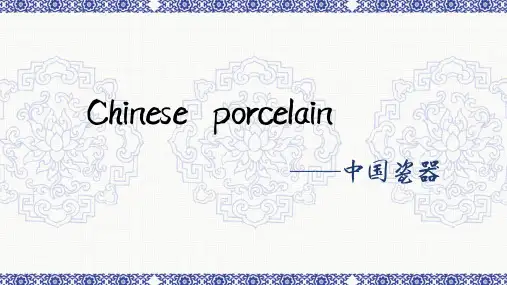中国瓷器介绍 英文版
- 格式:ppt
- 大小:22.86 MB
- 文档页数:50


中国瓷器介绍英文作文China has a long history of making exquisite porcelain. The tradition of making porcelain in China dates back thousands of years. It is known for its delicate beauty and intricate designs, which have made it highly sought after by collectors and art enthusiasts around the world.Chinese porcelain is famous for its fine quality and craftsmanship. The process of making porcelain involves shaping the clay, firing it at high temperatures, and then glazing it to create a smooth and glossy finish. This meticulous process results in porcelain that is not only beautiful to look at, but also durable and long-lasting.The designs of Chinese porcelain are often inspired by nature, with motifs such as flowers, birds, and landscapes being commonly used. These designs are carefully painted onto the porcelain using a variety of techniques, including freehand painting, stenciling, and carving. The result is a piece of porcelain that is not only visually stunning, butalso rich in symbolism and cultural significance.Chinese porcelain has played a significant role in the country's cultural and economic history. It has been usedfor both practical and decorative purposes, and has been highly prized both within China and abroad. In fact, Chinese porcelain has been a major export item for centuries, with traders from around the world eagerly seeking out these precious and beautiful pieces.Today, Chinese porcelain continues to be highly valued and admired. Collectors and enthusiasts from all over the world continue to seek out Chinese porcelain for its beauty, craftsmanship, and historical significance. Whether usedfor everyday dining or displayed as a work of art, Chinese porcelain remains a timeless and cherished part of China's cultural heritage.。




描写中国瓷器的英语作文Chinese porcelain, an exquisite embodiment of China's artistic heritage and technological prowess, has long captivated the world with its peerless beauty, craftsmanship, and cultural significance. Known as "China" in many Western languages, this ceramic art form reflects the nation's profound history, aesthetic sensibilities, and enduring spirit of innovation.中国瓷器,作为中国艺术遗产与技术实力的精致体现,长久以来以其无与伦比之美、工艺匠心及文化意义,深深吸引着全世界。
在许多西方语言中被直称为“China”,这种陶瓷艺术形式映射出中华民族深厚的历史底蕴、美学素养以及持久创新精神。
Paragraph 2:The origins of Chinese porcelain can be traced back to the Eastern Han Dynasty (25-220 AD), when kilns in present-day Henan Province produced the first proto-porcelain wares. However, it was during the Tang Dynasty (618-907) that true porcelain emerged, characterized by its fine texture, translucent body, and high firing temperature. The Song Dynasty (960-1279) witnessed significant advancements, particularly inceladon and black glazed ceramics, which were revered for their elegant simplicity and understated charm.中国瓷器的起源可追溯至东汉时期(公元25年-220年),当时河南境内的窑厂制造出首批原始瓷器。

The Splendor of Chinese Ceramics: A Fusion of Art and CraftsmanshipChinese ceramics, a symbol of the rich cultural heritage of China, have captivated the world with their intricate designs, exquisite craftsmanship, and timeless elegance. These masterpieces of art and engineering reflect the profound cultural and historical influences that have shaped China throughout the ages.The history of Chinese ceramics dates back to over8,000 years, with the earliest examples found in the Neolithic period. Since then, ceramic production has evolved and transformed, giving rise to a diverse array of styles, techniques, and materials. Each period in Chinese history has left its unique imprint on the ceramic arts, resulting in a diverse range of shapes, decorations, and glazes.The early ceramics were primarily made of earthenware and stoneware, with simple designs and textures. However, as time progressed, the techniques and materials used in ceramic production became more sophisticated. The introduction of porcelain, a type of fine, hard-bodiedceramic, marked a significant milestone in the history of Chinese ceramics. Porcelain, with its translucent quality and smooth surface, became a highly prized material forboth artistic and practical purposes.The art of Chinese ceramics is not just about the material and technique; it is also about the symbolism and cultural meanings embedded in each piece. Ceramics often serve as a medium for expressing social, religious, and political beliefs. They are often decorated with patterns and motifs that reflect the natural world, mythology, and folklore, thus serving as a bridge between the human and divine worlds.The most renowned centers for ceramic production in China include the Five Great Kiln Sites - the Yuyao, Ge, Xiang, Ding, and Jun kilns. Each of these kilns has its unique style and specialty, contributing to the rich diversity of Chinese ceramics. The Yuyao kiln, for instance, is known for its delicate and translucent porcelain, while the Ge kiln is renowned for its vibrant and decorative glazes.The influence of Chinese ceramics has been felt across the globe. From the Silk Road trade to the modern era, Chinese ceramics have been exported to various countries, becoming a symbol of luxury and refinement. Their influence can be seen in the ceramic traditions of other cultures, indicating their universal appeal and enduring value.In conclusion, Chinese ceramics are not just objects of art; they are a testament to the rich cultural heritage and craftsmanship of China. They are a bridge between the past and the present, connecting us to the ancient wisdom and creativity of the Chinese people. As we admire their beauty and elegance, we are reminded of the enduring power of art and culture to transcend time and space.**中国陶瓷的辉煌:艺术与工艺的融合**中国陶瓷,作为中国丰富文化遗产的象征,以其错综复杂的设计、精湛的工艺和永恒的优雅迷倒了世界。




介绍瓷器的英语作文1China has a long and glorious history of porcelain production. Porcelain originated in ancient China and has undergone continuous development and improvement over the centuries.In the Tang Dynasty, porcelain reached a high level of craftsmanship. The porcelain of this period was known for its exquisite designs and vivid colors. The shapes were diverse, from elegant vases to delicate bowls. The glazes were smooth and lustrous, adding to the charm of the pieces.The Song Dynasty witnessed significant breakthroughs in porcelain-making techniques. The porcelain of this era was characterized by its simplicity and elegance. The artisans paid great attention to the texture and form of the vessels, achieving a perfect balance between functionality and aesthetics. The celadon porcelain of the Song Dynasty was highly regarded for its subtle green color and fine texture.Throughout history, Chinese porcelain has not only been a practical item but also a work of art. It has been highly sought after both domestically and internationally, reflecting the rich cultural heritage and artistic achievements of China. Porcelain has become an important symbol of Chinese civilization, showcasing the wisdom and creativity of the Chinese people. Even today, the allure of porcelain remains undiminished,continuing to inspire and fascinate people around the world.2Porcelain is a remarkable art form that has captivated human civilization for centuries. The making of porcelain is a complex and delicate process that requires great skill and precision.The selection of raw materials is of utmost importance. High-quality clay, kaolin, and feldspar are often chosen. These materials are carefully mixed in specific proportions to achieve the desired texture and properties.Shaping the porcelain is a true art. Skilled artisans use various techniques such as wheel throwing or hand molding to give the porcelain its initial form. In Jingdezhen, for instance, traditional methods are still passed down through generations, ensuring the creation of exquisite pieces.The firing process is the key to transforming the raw material into a beautiful and durable porcelain. It involves heating the shaped pieces to extremely high temperatures in special kilns. This process not only solidifies the structure but also gives the porcelain its characteristic smoothness and translucency.In modern times, innovations in porcelain making have emerged. Advanced technologies have allowed for more precise control of temperature and atmosphere during firing, resulting in improved quality and consistency. New designs and decorative techniques have also expanded the range of possibilities, making porcelain more accessible andappealing to a wider audience.In conclusion, the art of porcelain making is a combination of tradition and innovation. It continues to enchant us with its beauty and craftsmanship, standing as a testament to human creativity and ingenuity.3Porcelain, a remarkable creation of human civilization, has a wide range of types and uses that have fascinated people for centuries. One of the common types is tableware porcelain. In our daily lives, we often come across exquisite porcelain plates, bowls, and cups in our dining rooms. These porcelain tableware not only serve practical purposes but also add an elegant touch to our dining experience. The delicate patterns and smooth texture of the porcelain make our meals more enjoyable.Another type is decorative porcelain. In museums, we can behold precious porcelain vases and figurines. These works of art, crafted with meticulous attention to detail and exquisite craftsmanship, showcase the creativity and skill of the artisans. They are not merely objects but carriers of history and culture.Porcelain is also used in various other aspects. Some porcelain items are designed as ornaments for our living spaces, enhancing the aesthetic appeal of our homes. Moreover, in some special occasions or ceremonies, porcelain plays an important role, symbolizing elegance and refinement.In conclusion, porcelain, with its diverse types and versatile uses, hasbecome an integral part of our lives and a testament to human ingenuity and creativity.4Porcelain is a remarkable art form that has captivated the world with its beauty and diversity. Different countries have developed their own unique styles and characteristics in porcelain production, each with its own charm.China, the birthplace of porcelain, has a long and glorious history. Chinese porcelain is renowned for its exquisite craftsmanship, delicate patterns, and rich colors. The traditional blue and white porcelain, with its elegant blue designs on a white background, is a classic example. The detailed paintings often depict scenes from nature, history, or myths, showcasing the depth of Chinese culture.In contrast, Japanese porcelain has a more minimalist and understated aesthetic. It emphasizes simplicity and purity, with clean lines and subtle colors. Japanese porcelain often features nature-inspired motifs such as cherry blossoms or bamboo, reflecting the country's deep connection with nature.Turning our attention to England, English porcelain is known for its elegance and refinement. It often incorporates elaborate gold detailing and floral patterns, giving it a regal and sophisticated look. The combination of fine materials and meticulous workmanship makes English porcelainhighly sought after.Each country's porcelain represents not only its artistic traditions but also its cultural values and historical background. The diversity of porcelain styles from around the world is a testament to the universal appeal and creative potential of this remarkable art form. It serves as a reminder of the beauty that can emerge when different cultures and creative expressions come together.5Porcelain, a remarkable art form with a long and illustrious history, holds significant value in both the realm of art and collection. Its allure lies not only in its exquisite craftsmanship but also in the cultural and historical significance it embodies.Take, for instance, some rare ancient porcelain pieces that have commanded astonishing prices at auctions. These treasures, often crafted with meticulous attention to detail and embodying the essence of a bygone era, are highly sought after by collectors and enthusiasts alike. The price tags attached to these rarities not only reflect their aesthetic appeal but also speak volumes about their scarcity and historical importance.Furthermore, renowned artists have been inspired by porcelain and have incorporated it into their masterpieces. Their creative endeavors have elevated porcelain from a mere object of utility to a medium of artistic expression. The fusion of artistic vision and the inherent beauty ofporcelain has resulted in works that captivate the viewer's imagination and leave a lasting impression.In conclusion, porcelain is not just a commodity but a testament to human creativity and cultural heritage. Its value in the art and collection world continues to thrive, enchanting generations with its timeless charm and profound significance.。
中国瓷器英文小作文英文:Chinese porcelain has a long history and is known for its exquisite craftsmanship and beautiful designs. As a Chinese person, I am proud of the rich cultural heritage that porcelain represents.Porcelain was first developed in China during the Tang Dynasty (618-907 AD) and has been highly prized ever since. The creation of porcelain involves a complex process of mixing different types of clay, shaping the clay into the desired form, and then firing it at high temperatures. The result is a material that is both strong and delicate, with a smooth and shiny surface.One of the most famous types of Chinese porcelain is blue and white porcelain, which features intricate designs in blue paint on a white background. This style became popular during the Ming Dynasty (1368-1644 AD) and is stillhighly sought after today.Another notable style is the famille rose porcelain, which features brightly colored designs on a white background. This style was popular during the Qing Dynasty (1644-1912 AD) and is known for its intricate details and vivid colors.Chinese porcelain has influenced the art and culture of many other countries, including Japan, Korea, and Europe. In fact, it was the demand for Chinese porcelain in Europe that led to the development of porcelain factories in countries like Germany and France.中文:中国瓷器有着悠久的历史,以其精湛的工艺和美丽的设计而闻名。
介绍瓷器英文小作文英文:As a lover of traditional Chinese culture, I am always fascinated by the beauty and elegance of Chinese porcelain. Porcelain, also known as china or fine china, is a type of ceramic material that has been produced in China for centuries. It is famous for its delicate texture, translucent appearance, and exquisite decoration.One of my favorite types of Chinese porcelain is blue and white porcelain. This type of porcelain is decorated with blue designs on a white background, and it is aclassic example of Chinese ceramic art. The blue and white porcelain was first produced during the Yuan dynasty (1271-1368), and it became very popular during the Ming dynasty (1368-1644). The blue color was derived from cobalt oxide, which was imported from Persia, while the white background was made from a type of clay called kaolin.Another type of Chinese porcelain that I admire is celadon porcelain. Celadon porcelain is a type of green-glazed porcelain that was first produced during the Song dynasty (960-1279). The celadon glaze gives the porcelain a subtle green color, and it is created by firing the porcelain at a high temperature in a reducing atmosphere. Celadon porcelain is famous for its simple and elegant designs, and it is often used for tea sets and vases.Chinese porcelain is not only a work of art but also a symbol of Chinese culture. It reflects the wisdom, creativity, and aesthetic taste of the Chinese people. Chinese porcelain has been exported to many countries and has become a cultural bridge between China and the world.中文:作为一个热爱中国传统文化的人,我总是被中国瓷器的美丽和优雅所吸引。
英语作文介绍中国瓷器Chinese porcelain is one of the most famous andexquisite forms of ceramic art in the world. It has a long history, dating back to the Han Dynasty (206 BC – 220 AD), and has been highly prized for its beauty, durability, and delicacy for centuries.Chinese porcelain is made from a mixture of kaolin, feldspar, and quartz. The clay is carefully selected and prepared, then shaped by hand or on a potter's wheel into various forms, such as bowls, plates, vases, and figurines. The pieces are then glazed and fired at high temperaturesin a kiln, which gives them their characteristic hardness and translucency.One of the most distinctive features of Chinese porcelain is its decorative patterns and designs. These can be painted on the surface of the piece, or carved into the clay before firing. The most famous and highly prizedstyles of Chinese porcelain are blue and white, famille rose, and famille verte.Blue and white porcelain is characterized by its deep blue cobalt glaze and intricate designs, often depicting scenes from nature or mythology. It was first developed during the Yuan Dynasty (1271-1368), but reached its peak of popularity during the Ming Dynasty (1368-1644).Famille rose porcelain is known for its colorful, delicate designs, often featuring flowers, birds, and other natural motifs. It originated during the Qing Dynasty (1644-1912), and was highly prized by the imperial court and the wealthy elite.Famille verte porcelain is similar to famille rose, but features a more muted color palette of green, yellow, and brown. It was developed during the Kangxi era (1662-1722) of the Qing Dynasty, and was also highly prized by the imperial court.In addition to these famous styles, Chinese porcelain has also been influenced by various other cultural and artistic traditions throughout its history. For example, during the Tang Dynasty (618-907), porcelain was often decorated with calligraphy and poetry, and during the SongDynasty (960-1279), it was often adorned with intricate geometric patterns.Today, Chinese porcelain remains a highly prized and sought-after art form around the world. Its beauty and craftsmanship continue to inspire artists and collectors alike, and it is a testament to the rich cultural heritage of China.。
Chinese PorcelainsGood morning, everyone!Today, I want to tell you something about Chinese Porcelains. China is the hometown of porcelains. It’s an important creation of the working people of Han nationality. Porcelain developed from Pottery. The earliest porcelain appeared in Shang and Zhou dynasty about 3,000 years ago. The true meaning of the Chinese porcelains produced in the Eastern Han Dynasty.In The Middle Ages, accompanied by Chinese Porcelains export, Chinese began to known in the world as “Country of Porcelain”. By the Song Dynasty some seven centuries later, the porcelain industry was flourishing. Ming and Qing Dynasty was the heyday of Chinese Porcelains. The quantity and quality of porcelain production has reached the peak. Jingdezhen as the “Porcelain Capital” status has been established.Welcome to Jingdezhen Museum. Jingdezhen is located in northeastern Jiangxi. Jingdezhen porcelain is the pearl in the treasure house of Chinese art and culture. In its long and glorious history, a brilliant art and craft has been handed down. The feature of Jingdezhen Porcelain was described as being “as white as jade, as thin as paper, as bright as a mirror, with a sound as clear as a bell.” The four traditional porcelains are Blue and white porcelain, Glowingporcelain, Color glaze porcelain, and Famille-rose porcelain.Blue and white porcelain has a white base with blue designs. Blue designs are applied to the white body of the porcelain, making it appear elegant, fresh and full of vigor. Its unique artistic connotation is the perfect combined of traditional and modern arts.Glowing porcelain is also called “Mitong”in China. Craftsmen carve out many regular “delicate eyes”in the porcelain body, and then fire these holes with the glaze into the bright hole. European called it as “the transparent rice pattern”.Jingdezhen’s colorful glaze is famous for all over the world. It contains a long tradition, and is gradually concluded by our ancestors during the long-time producing and experimenting. Our ancestors had accumulated rich experience in the long time producing and struggling. Famile-rose porcelain also called soft decorative porcelain, which is one of the four traditional porcelain of Jingdezhen. As known as soft colors, is over glaze decoration of porcelain wares. “A man without porcelain is not noble. A room without porcelain is indecent.”Porcelain is ubiquitous in our culture.Thank you for your attention. Next, we will have a lunch in a five star hotel.彭雅玲。